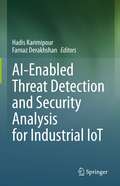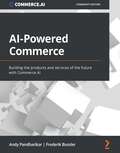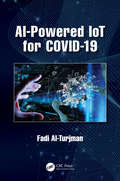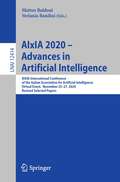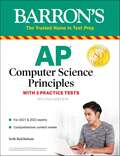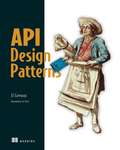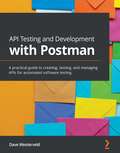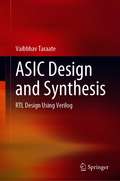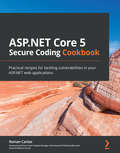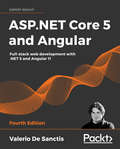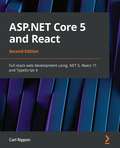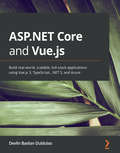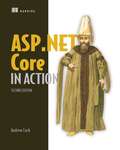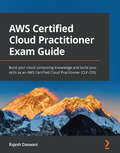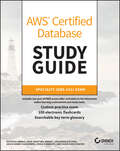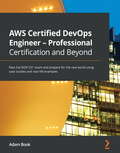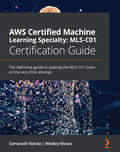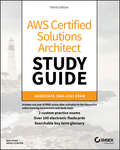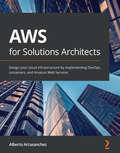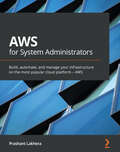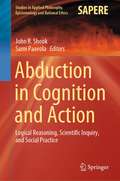- Table View
- List View
AI-Enabled Threat Detection and Security Analysis for Industrial IoT
by Hadis Karimipour Farnaz DerakhshanThis contributed volume provides the state-of-the-art development on security and privacy for cyber-physical systems (CPS) and industrial Internet of Things (IIoT). More specifically, this book discusses the security challenges in CPS and IIoT systems as well as how Artificial Intelligence (AI) and Machine Learning (ML) can be used to address these challenges. Furthermore, this book proposes various defence strategies, including intelligent cyber-attack and anomaly detection algorithms for different IIoT applications. Each chapter corresponds to an important snapshot including an overview of the opportunities and challenges of realizing the AI in IIoT environments, issues related to data security, privacy and application of blockchain technology in the IIoT environment. This book also examines more advanced and specific topics in AI-based solutions developed for efficient anomaly detection in IIoT environments. Different AI/ML techniques including deep representation learning, Snapshot Ensemble Deep Neural Network (SEDNN), federated learning and multi-stage learning are discussed and analysed as well. Researchers and professionals working in computer security with an emphasis on the scientific foundations and engineering techniques for securing IIoT systems and their underlying computing and communicating systems will find this book useful as a reference. The content of this book will be particularly useful for advanced-level students studying computer science, computer technology, cyber security, and information systems. It also applies to advanced-level students studying electrical engineering and system engineering, who would benefit from the case studies.
AI-First Healthcare
by Kerrie L. Holley Siupo BeckerAI is poised to transform every aspect of healthcare, including the way we manage personal health, from customer experience and clinical care to healthcare cost reductions. This practical book is one of the first to describe present and future use cases where AI can help solve pernicious healthcare problems.Kerrie Holley and Siupo Becker provide guidance to help informatics and healthcare leadership create AI strategy and implementation plans for healthcare. With this book, business stakeholders and practitioners will be able to build knowledge, a roadmap, and the confidence to support AIin their organizations—without getting into the weeds of algorithms or open source frameworks.Cowritten by an AI technologist and a medical doctor who leverages AI to solve healthcare’s most difficult challenges, this book covers:The myths and realities of AI, now and in the futureHuman-centered AI: what it is and how to make it possibleUsing various AI technologies to go beyond precision medicineHow to deliver patient care using the IoT and ambient computing with AIHow AI can help reduce waste in healthcareAI strategy and how to identify high-priority AI application
AI-Powered Commerce: Building the products and services of the future with Commerce.AI
by Andy Pandharikar Frederik BusslerLearn how to use artificial intelligence for product and service innovation, including the diverse use cases of Commerce.AIKey FeaturesLearn how to integrate data and AI in your innovation workflowsUnlock insights into how various industries are using AI for innovationApply your knowledge to real innovation use cases like product strategy and market intelligenceBook DescriptionCommerce.AI is a suite of artificial intelligence (AI) tools, trained on over a trillion data points, to help businesses build next-gen products and services. If you want to be the best business on the block, using AI is a must.Developers and analysts working with AI will be able to put their knowledge to work with this practical guide. You'll begin by learning the core themes of new product and service innovation, including how to identify market opportunities, come up with ideas, and predict trends. With plenty of use cases as reference, you'll learn how to apply AI for innovation, both programmatically and with Commerce.AI. You'll also find out how to analyze product and service data with tools such as GPT-J, Python pandas, Prophet, and TextBlob. As you progress, you'll explore the evolution of commerce in AI, including how top businesses today are using AI. You'll learn how Commerce.AI merges machine learning, product expertise, and big data to help businesses make more accurate decisions. Finally, you'll use the Commerce.AI suite for product ideation and analyzing market trends.By the end of this artificial intelligence book, you'll be able to strategize new product opportunities by using AI, and also have an understanding of how to use Commerce.AI for product ideation, trend analysis, and predictions.What you will learnFind out how machine learning can help you identify new market opportunitiesUnderstand how to use consumer data to create new products and servicesUse state-of-the-art AI frameworks and tools for data analysisLaunch, track, and improve products and services with AIRise above the competition with unparalleled insights from AITurn customer touchpoints into business winsGenerate high-conversion product and service copyWho this book is forThis AI book is for AI developers, data scientists, data product managers, analysts, and consumer insights professionals. The book will guide you through the process of product and service innovation, no matter your pre-existing skillset.
AI-Powered IoT for COVID-19
by Fadi Al-TurjmanThe Internet of Things (IoT) has made revolutionary advances in the utility grid as we know it. Among these advances, intelligent medical services are gaining much interest. The use of Artificial Intelligence (AI) is increasing day after day in fighting one of the most significant viruses, COVID-19. The purpose of this book is to present the detailed recent exploration of AI and IoT in the COVID-19 pandemic and similar applications. The integrated AI and IoT paradigm is widely used in most medical applications, as well as in sectors that deal with transacting data every day. This book can be used by computer science undergraduate and postgraduate students; researchers and practitioners; and city administrators, policy makers, and government regulators. It presents a smart and up-to-date model for COVID-19 and similar applications. Novel architectural and medical use cases in the smart city project are the core aspects of this book. The wide variety of topics it presents offers readers multiple perspectives on a variety of disciplines. Prof. Dr. Fadi Al-Turjman received his PhD in computer science from Queen’s University, Kingston, Ontario, Canada, in 2011. He is a full professor and research center director at Near East University, Nicosia, Cyprus.
AIxIA 2020 – Advances in Artificial Intelligence: XIXth International Conference of the Italian Association for Artificial Intelligence, Virtual Event, November 25–27, 2020, Revised Selected Papers (Lecture Notes in Computer Science #12414)
by Matteo Baldoni Stefania BandiniThis book constitutes the refereed post proceedings of the XIXth International Conference of the Italian Association for Artificial Intelligence, AIxIA 2020, held in Milano, Italy, in November 2020.Due to the COVID-19 pandemic, the conference was "rebooted"/ re-organized w.r.t. the original format.The 27 full papers were carefully reviewed and selected from 89 submissions. The society aims at increasing the public awareness of Artificial Intelligence, encouraging the teaching and promoting research in the field.
AP Computer Science Principles with 3 Practice Tests: with 3 practice tests (Barron's Test Prep)
by Seth ReichelsonBarron&’s AP Computer Science Principles is designed to help students prepare for exam topics, regardless of what computer language or method they learned. The book has been updated to include the course changes that will be implemented in the 2020-2021 academic year. The College Board has announced that there are May 2021 test dates available are May 3-7 and May 10-14, 2021. This edition includes:Three practice exams in the book, with an additional exam available onlineIn-depth instructions on how to complete the Explore Performance Tasks and the Create Performance Tasks.Sample responses that earn high scores and sample responses that earn low scoresThe questions and examples all reflect the style of recent exam questions and cover the essential knowledge topics outlined by the CollegeBoard.
API Design Patterns
by JJ GeewaxAPI Design Patterns lays out a set of design principles for building internal and public-facing APIs.Summary A collection of best practices and design standards for web and internal APIs. In API Design Patterns you will learn: Guiding principles for API patterns Fundamentals of resource layout and naming Handling data types for any programming language Standard methods that ensure predictability Field masks for targeted partial updates Authentication and validation methods for secure APIs Collective operations for moving, managing, and deleting data Advanced patterns for special interactions and data transformations API Design Patterns reveals best practices for building stable, user-friendly APIs. These design patterns can be applied to solve common API problems and flexibly altered to fit your specific needs. Hands-on examples and relevant use-cases illustrate patterns for API fundamentals, advanced functionalities, and even uncommon scenarios. Purchase of the print book includes a free eBook in PDF, Kindle, and ePub formats from Manning Publications. About the technology APIs are contracts that define how applications, services, and components communicate. API design patterns provide a shared set of best practices, specifications and standards that ensure APIs are reliable and simple for other developers to use. This book collects and explains the most important patterns from both the API design community and the experts at Google. About the book API Design Patterns lays out a set of design principles for building internal and public-facing APIs. Google API expert JJ Geewax presents patterns that ensure your APIs are consistent, scalable, and flexible. You&’ll improve the design of the most common APIs, plus discover techniques for tricky edge cases. Precise illustrations, relevant examples, and detailed scenarios make every pattern clear and easy to understand. What's inside Guiding principles for API patterns Fundamentals of resource layout and naming Advanced patterns for special interactions and data transformations A detailed case-study on building an API and adding features About the reader For developers building web and internal APIs in any language. About the author JJ Geewax is a software engineer at Google, focusing on Google Cloud Platform, API design, and real-time payment systems. He is also the author of Manning&’s Google Cloud Platform in Action. Table of Contents PART 1 INTRODUCTION 1 Introduction to APIs 2 Introduction to API design patterns PART 2 DESIGN PRINCIPLES 3 Naming 4 Resource scope and hierarchy 5 Data types and defaults PART 3 FUNDAMENTALS 6 Resource identification 7 Standard methods 8 Partial updates and retrievals 9 Custom methods 10 Long-running operations 11 Rerunnable jobs PART 4 RESOURCE RELATIONSHIPS 12 Singleton sub-resources 13 Cross references 14 Association resources 15 Add and remove custom methods 16 Polymorphism PART 5 COLLECTIVE OPERATIONS 17 Copy and move 18 Batch operations 19 Criteria-based deletion 20 Anonymous writes 21 Pagination 22 Filtering 23 Importing and exporting PART 6 SAFETY AND SECURITY 24 Versioning and compatibility 25 Soft deletion 26 Request deduplication 27 Request validation 28 Resource revisions 29 Request retrial 30 Request authentication
API Testing and Development with Postman: A practical guide to creating, testing, and managing APIs for automated software testing
by Dave WesterveldExplore the world of APIs and learn how to integrate them the production-ready applications using Postman and the Newman CLIKey FeaturesLearn the tenets of effective API testing and API designGain an in-depth understanding of the various features Postman has to offerKnow when and how to use Postman for creating high-quality APIs for software and web appsBook DescriptionPostman enables the exploration and testing of web APIs, helping testers and developers figure out how an API works. With Postman, you can create effective test automation for any APIs. If you want to put your knowledge of APIs to work quickly, this practical guide to using Postman will help you get started. The book provides a hands-on approach to learning the implementation and associated methodologies that will have you up and running with Postman in no time. Complete with step-by-step explanations of essential concepts, practical examples, and self-assessment questions, this book begins by taking you through the principles of effective API testing. A combination of theory coupled with real-world examples will help you learn how to use Postman to create well-designed, documented, and tested APIs. You'll then be able to try some hands-on projects that will teach you how to add test automation to an already existing API with Postman, and guide you in using Postman to create a well-designed API from scratch. By the end of this book, you'll be able to use Postman to set up and run API tests for any API that you are working with. What you will learnFind out what is involved in effective API testing Use data-driven testing in Postman to create scalable API testsUnderstand what a well-designed API looks likeBecome well-versed with API terminology, including the different types of APIsGet to grips with performing functional and non-functional testing of an APIDiscover how to use industry standards such as OpenAPI and mocking in PostmanWho this book is forThe book is for software testing professionals and software developers looking to improve product and API quality through API test automation. You will find this book useful if understand APIs and want to build your skills for creating, testing, and documenting APIs. The book assumes beginner-level knowledge of JavaScript and API development.
AR and VR Using the WebXR API: Learn to Create Immersive Content with WebGL, Three.js, and A-Frame
by Rakesh BaruahGain an in-depth knowledge in immersive web development to create augmented reality (AR) and virtual reality (VR) applications inside web browsers using WebXR API, WebGL, Three.js, and A-Frame. This project-based book will provide the practice and portfolio content to make the most of what the futures of spatial computing and immersive technology have to offer.Beginning with technical analysis of how web browsers function, the book covers programming languages such as WebGL, JavaScript, and HTML, with an eye on a complete understanding of the WebXR lifecycle. You'll then explore how contemporary web browsers work at the code level and see how to set up a local development server and use it with the Visual Studio Code IDE to create 3D animation in the WebGL programming language. With a familiarity of the web-rendering pipeline in place, you’ll venture on to WebGL abstractions such as the Three.js JavaScript library and Mozilla’s A-Frame XR Framework, which use WebXR to create high-end visual effects. In the final projects of the book, you’ll create an augmented reality web session for an Android phone device, and create a VR scene in A-Frame (built on Three.js) to demo essential components of the WebXR API pertaining to user positioning and interaction.Game engines have become common-place for the creation of mixed reality content. However, developers not interested in learning entirely new workflows may be better suited to work within a medium almost universally open to all—the web; AR and VR Using the WebXR API will show you the way.What You'll LearnMaster the creation of virtual reality and augmented reality features for web pagePrepare to work as an immersive web developer with a portfolio of projects in sought-after technologiesReview the fundamentals of writing shaders in WebGLExperience the unity between client, server, and cloud architecture as it applies to location-based ARWho This Book Is ForAspiring immersive web developers and developers already familiar with the fundamentals of web development who want to further explore topics such as spatial computing, computer vision, spatial anchors, and cloud-computing for multi-user social experiences.
ASIC Design and Synthesis: RTL Design Using Verilog
by Vaibbhav TaraateThis book describes simple to complex ASIC design practical scenarios using Verilog. It builds a story from the basic fundamentals of ASIC designs to advanced RTL design concepts using Verilog. Looking at current trends of miniaturization, the contents provide practical information on the issues in ASIC design and synthesis using Synopsys DC and their solution. The book explains how to write efficient RTL using Verilog and how to improve design performance. It also covers architecture design strategies, multiple clock domain designs, low-power design techniques, DFT, pre-layout STA and the overall ASIC design flow with case studies. The contents of this book will be useful to practicing hardware engineers, students, and hobbyists looking to learn about ASIC design and synthesis.
ASP.NET Core 5 Secure Coding Cookbook: Practical recipes for tackling vulnerabilities in your ASP.NET web applications
by Roman CanlasLearn how to secure your ASP.NET Core web app through robust and secure codeKey FeaturesDiscover the different types of security weaknesses in ASP.NET Core web applications and learn how to fix themUnderstand what code makes an ASP.NET Core web app unsafeBuild your secure coding knowledge by following straightforward recipesBook DescriptionASP.NET Core developers are often presented with security test results showing the vulnerabilities found in their web apps. While the report may provide some high-level fix suggestions, it does not specify the exact steps that you need to take to resolve or fix weaknesses discovered by these tests. In ASP.NET Secure Coding Cookbook, you'll start by learning the fundamental concepts of secure coding and then gradually progress to identifying common web app vulnerabilities in code. As you progress, you'll cover recipes for fixing security misconfigurations in ASP.NET Core web apps. The book further demonstrates how you can resolve different types of Cross-Site Scripting. A dedicated section also takes you through fixing miscellaneous vulnerabilities that are no longer in the OWASP Top 10 list. This book features a recipe-style format, with each recipe containing sample unsecure code that presents the problem and corresponding solutions to eliminate the security bug. You'll be able to follow along with each step of the exercise and use the accompanying sample ASP.NET Core solution to practice writing secure code. By the end of this book, you'll be able to identify unsecure code causing different security flaws in ASP.NET Core web apps and you'll have gained hands-on experience in removing vulnerabilities and security defects from your code.What you will learnUnderstand techniques for squashing an ASP.NET Core web app security bugDiscover different types of injection attacks and understand how you can prevent this vulnerability from being exploitedFix security issues in code relating to broken authentication and authorizationEliminate the risks of sensitive data exposure by getting up to speed with numerous protection techniquesPrevent security misconfiguration by enabling ASP.NET Core web application security featuresExplore other ASP.NET web application vulnerabilities and secure coding best practicesWho this book is forThis ASP.NET Core book is for intermediate-level ASP.NET Core web developers and software engineers who use the framework to develop web applications and are looking to focus on their security using coding best practices. The book is also for application security engineers, analysts, and specialists who want to know more about securing ASP.NET Core using code and understand how to resolve issues identified by the security tests they perform daily.
ASP.NET Core 5 and Angular: Full-stack web development with .NET 5 and Angular 11, 4th Edition
by Valerio De SanctisBuild a simple, yet fully functional modern web application using .NET 5, Entity Framework Core, and Angular 11Key FeaturesComprehensively updated with the latest features and additions in ASP.NET Core 5 and Angular 11Design, build, and deploy a Single Page Application or Progressive Web App with ASP.NET Core and AngularAdopt a full stack approach to handle data management, Web APIs, application design, testing, SEO, security, and deploymentBook DescriptionLearning full-stack development calls for knowledge of both front-end and back-end web development. ASP.NET Core 5 and Angular, Fourth Edition will get you started with Angular to build robust web applications as well as the ASP.NET Core 5 and Web API Controllers to implement API calls and server-side routing in the back-end. This fully revised edition includes a side-by-side comparison of the Visual Studio Angular app versus NG App and coverage of the Angular routing module. You will learn how to build a data model with Entity Framework Core, alongside utilizing the Entity Core Fluent API and EntityTypeConfiguration class. As you progress, you will learn how to handle user input with Angular reactive forms and front-end and back-end validators for maximum effect. You will later explore the advanced debugging and unit testing features provided by xUnit.net (.NET 5) and Jasmine, as well as Karma for Angular. Further, you will dive deep into progressive web applications (PWAs), learning about their technical requirements, testing, and converting SWAs to PWAs. Finally, you will learn how to deploy apps on Windows, Linux, and Azure using IIS, Kestrel, and nginx. By the end of this book, you will be equipped with the skills you need to create, debug, and deploy efficient web applications using ASP.NET Core and Angular.What you will learnImplement a Web API interface with ASP.NET Core and consume it with Angular using RxJS ObservablesSet up a SQL database server using a local instance or a cloud data storePerform C# and TypeScript debugging using Visual Studio 2019Create TDD and BDD unit tests using xUnit, Jasmine, and KarmaExplore the EF Core Fluent API and EntityTypeConfiguration classesPerform DBMS structured logging using third-party providers such as SeriLogDeploy a Web application to Windows and Linux web servers, or to cloud-based PaaS solutions such as Azure App ServiceWho this book is forThis book is for experienced ASP.NET developers who already possess some experience with ASP.NET Core and Angular and are looking to learn how to use them together to create production-ready Single Page Applications (SPAs) or Progressive Web Applications (PWAs).However, the fully documented code samples (also available on GitHub) and the step-by-step implementation tutorials make this book easy-to-understand - even for beginners.
ASP.NET Core 5 and React: Full-stack web development using .NET 5, React 17, and TypeScript 4, 2nd Edition
by Carl RipponBuild fully functional, cloud-ready, and professional web applications using the latest features in the .NET 5 framework and React.js with Microsoft AzureKey FeaturesExplore the new features of .NET 5 with this updated edition of ASP.NET Core 53 and ReactDiscover strategies for adopting a full-stack development approach, clean architecture techniques, and development best practicesLearn how to manage data, design and package applications, and secure your web appsBook DescriptionMicrosoft's .NET framework is a robust server-side framework, now even more powerful thanks to the recent unification of the Microsoft ecosystem with the .NET 5 framework. This updated second edition addresses these changes in the .NET framework and the latest release of React. The book starts by taking you through React and TypeScript components for building an intuitive single-page application and then shows you how to design scalable REST APIs that can integrate with a React-based frontend. Next, you'll get to grips with the latest features, popular patterns, and tools available in the React ecosystem, including function-based components, React Router, and Redux. As you progress through the chapters, you'll learn how to use React with TypeScript to make the frontend robust and maintainable and cover key ASP.NET 5 features such as API controllers, attribute routing, and model binding to build a sturdy backend. In addition to this, you'll explore API security with ASP.NET 5 identity and authorization policies and write reliable unit tests using both .NET and React, before deploying your app on Azure. By the end of this book, you'll have gained the knowledge you need to enhance your C# and JavaScript skills and build full-stack, production-ready applications with ASP.NET 5 and React.What you will learnBuild RESTful APIs with .NET 5 using API controllersSecure REST APIs with identity and authorization policiesCreate strongly typed, interactive, and function-based React components using HooksUnderstand how to style React components using Emotion.jsPerform client-side state management with ReduxRun a range of automated tests on the frontend and backendImplement continuous integration and continuous delivery (CI/CD) processes in Azure using Azure DevOpsWho this book is forIf you're a web developer looking to get up to speed with full-stack web application development with .NET Core and React, this book is for you. Although the book does not assume any knowledge of React, a basic understanding of .NET Core will help you to get to grips with the concepts covered.
ASP.NET Core and Vue.js: Build real-world, scalable, full-stack applications using Vue.js 3, TypeScript, .NET 5, and Azure
by Devlin Basilan DuldulaoA guide to building enterprise, cloud-ready full-stack web applications using TypeScript, Vue.js 3, and ASP.NET Core 5 for busy developersKey FeaturesLearn how to implement clean architecture in the latest ASP.NET Core 5 Web APIDevelop Vue.js 3 single-page applications (SPAs) using TypeScript or JavaScript programming and Vuex state managementSecure, test, and deploy your full-stack web application to Azure CloudBook DescriptionVue.js 3 is faster and smaller than the previous version, and TypeScript's full support out of the box makes it a more maintainable and easier-to-use version of Vue.js. Then, there's ASP.NET Core 5, which is the fastest .NET web framework today. Together, Vue.js for the frontend and ASP.NET Core 5 for the backend make a powerful combination. This book follows a hands-on approach to implementing practical methodologies for building robust applications using ASP.NET Core 5 and Vue.js 3. The topics here are not deep dive and the book is intended for busy .NET developers who have limited time and want a quick implementation of a clean architecture with popular libraries. You'll start by setting up your web app's backend, guided by clean architecture, command query responsibility segregation (CQRS), mediator pattern, and Entity Framework Core 5. The book then shows you how to build the frontend application using best practices, state management with Vuex, Vuetify UI component libraries, Vuelidate for input validations, lazy loading with Vue Router, and JWT authentication. Later, you'll focus on testing and deployment. All the tutorials in this book support Windows 10, macOS, and Linux users. By the end of this book, you'll be able to build an enterprise full-stack web app, use the most common npm packages for Vue.js and NuGet packages for ASP.NET Core, and deploy Vue.js and ASP.NET Core to Azure App Service using GitHub Actions.What you will learnDiscover CQRS and mediator pattern in the ASP.NET Core 5 Web APIUse Serilog, MediatR, FluentValidation, and Redis in ASP.NETExplore common Vue.js packages such as Vuelidate, Vuetify, and VuexManage complex app states using the Vuex state management libraryWrite integration tests in ASP.NET Core using xUnit and FluentAssertionsDeploy your app to Microsoft Azure using the new GitHub Actions for continuous integration and continuous deployment (CI/CD)Who this book is forThis app development book is for .NET developers who want to get started with Vue.js and build full-stack real-world enterprise web applications. Developers looking to build a proof-of-concept application quickly and pragmatically using their existing knowledge of ASP.NET Core as well as developers who want to write readable and maintainable code using TypeScript and the C# programming language will also find this book useful. The book assumes intermediate-level .NET knowledge along with an understanding of C# programming, JavaScript, and ECMAScript.
ASP.NET Core in Action
by Andrew LockASP.NET Core in Action, Second Edition is a comprehensive guide to creating web applications with ASP.NET Core 5.0. Go from basic HTTP concepts to advanced framework customization.Summary Fully updated to ASP.NET 5.0, ASP.NET Core in Action, Second Edition is a hands-on primer to building cross-platform web applications with your C# and .NET skills. Even if you've never worked with ASP.NET you'll start creating productive cross-platform web apps fast. And don&’t worry about late-breaking changes to ASP.NET Core. Purchase of the print book includes a free eBook in PDF, Kindle, and ePub formats from Manning Publications. About the technology Build full-stack web applications that run anywhere. Developers love ASP.NET Core for its libraries and pre-built components that maximize productivity. Version 5.0 offers new features for server-side apps, as well as background services for cross-platform development. About the book ASP.NET Core in Action, Second Edition is a comprehensive guide to creating web applications with ASP.NET Core 5.0. Go from basic HTTP concepts to advanced framework customization. Illustrations and annotated code make learning visual and easy. Master logins, dependency injection, security, and more. This updated edition covers the latest features, including Razor Pages and the new hosting paradigm. What's inside Developing apps for Windows and non-Windows servers Configuring applications Building custom components Logging, testing, and security About the reader For intermediate C# developers. About the author Andrew Lock is a Microsoft MVP who has worked with ASP.NET Core since before its first release. Table of Contents PART 1 - GETTING STARTED WITH ASP.NET CORE 1 Getting started with ASP.NET Core 2 Your first application 3 Handling requests with the middleware pipeline 4 Creating a website with Razor Pages 5 Mapping URLs to Razor Pages using routing 6 The binding model: Retrieving and validating user input 7 Rendering HTML using Razor views 8 Building forms with Tag Helpers 9 Creating a Web API for mobile and client applications using MVC PART 2 - BUILDING COMPLETE APPLICATIONS 10 Service configuration with dependency injection 11 Configuring an ASP.NET Core application 12 Saving data with Entity Framework Core 13 The MVC and Razor Pages filter pipeline 14 Authentication: Adding users to your application with Identity 15 Authorization: Securing your application 16 Publishing and deploying your application PART 3 - EXTENDING YOUR APPLICATIONS 17 Monitoring and troubleshooting errors with logging 18 Improving your application&’s security 19 Building custom components 20 Building custom MVC and Razor Pages components 21 Calling remote APIs with IHttpClientFactory 22 Building background tasks and services 23 Testing your application
ATLAS Measurements of the Higgs Boson Coupling to the Top Quark in the Higgs to Diphoton Decay Channel (Springer Theses)
by Jennet Elizabeth DickinsonDuring Run 2 of the Large Hadron Collider, the ATLAS experiment recorded proton-proton collision events at 13 TeV, the highest energy ever achieved in a collider. Analysis of this dataset has provided new opportunities for precision measurements of the Higgs boson, including its interaction with the top quark. The Higgs-top coupling can be directly probed through the production of a Higgs boson in association with a top-antitop quark pair (ttH). The Higgs to diphoton decay channel is among the most sensitive for ttH measurements due to the excellent diphoton mass resolution of the ATLAS detector and the clean signature of this decay. Event selection criteria were developed using novel Machine Learning techniques to target ttH events, yielding a precise measurement of the ttH cross section in the diphoton channel and a 6.3 $\sigma$ observation of the ttH process in combination with other decay channels, as well as stringent limits on CP violation in the Higgs-top coupling.
AWS Certified Cloud Practitioner Exam Guide: Build your cloud computing knowledge and build your skills as an AWS Certified Cloud Practitioner (CLF-C01)
by Rajesh DaswaniDevelop proficiency in AWS technologies and validate your skills by becoming an AWS Certified Cloud PractitionerKey FeaturesDevelop the skills to design highly available and fault-tolerant solutions in the cloudLearn how to adopt best-practice security measures in your cloud applicationsAchieve credibility through industry-recognized AWS Cloud Practitioner certificationBook DescriptionAmazon Web Services is the largest cloud computing service provider in the world. Its foundational certification, AWS Certified Cloud Practitioner (CLF-C01), is the first step to fast-tracking your career in cloud computing. This certification will add value even to those in non-IT roles, including professionals from sales, legal, and finance who may be working with cloud computing or AWS projects. If you are a seasoned IT professional, this certification will make it easier for you to prepare for more technical certifications to progress up the AWS ladder and improve your career prospects.The book is divided into four parts. The first part focuses on the fundamentals of cloud computing and the AWS global infrastructure. The second part examines key AWS technology services, including compute, network, storage, and database services. The third part covers AWS security, the shared responsibility model, and several security tools. In the final part, you'll study the fundamentals of cloud economics and AWS pricing models and billing practices.Complete with exercises that highlight best practices for designing solutions, detailed use cases for each of the AWS services, quizzes, and two complete practice tests, this CLF-C01 exam study guide will help you gain the knowledge and hands-on experience necessary to ace the AWS Certified Cloud Practitioner exam.What you will learnCreate an AWS account to access AWS cloud services in a secure and isolated environmentUnderstand identity and access management (IAM), encryption, and multifactor authentication (MFA) protectionConfigure multifactor authentication for your IAM accountsConfigure AWS services such as EC2, ECS, Lambda, VPCs, and Route53Explore various storage and database services such as S3, EBS, and Amazon RDSStudy the fundamentals of modern application design to shift from a monolithic to microservices architectureDesign highly available solutions with decoupling ingrained in your design architectureWho this book is forIf you're looking to advance your career and gain expertise in cloud computing, with particular focus on the AWS platform, this book is for you. This guide will help you ace the AWS Certified Cloud Practitioner Certification exam, enabling you to embark on a rewarding career in cloud computing. No previous IT experience is essential to get started with this book, since it covers core IT fundamentals from the ground up.
AWS Certified Database Study Guide: Specialty (DBS-C01) Exam
by Matheus Arrais Rene Martinez Bravet Leonardo Ciccone Angie Nobre Cocharero Erika Kurauchi Hugo RozestratenValidate your AWS Cloud database skills! AWS Certified Database Study Guide: Specialty (DBS-C01) Exam focuses on helping you to understand the basic job role of a database administrator / architect and to prepare for taking the certification exam. This is your opportunity to take the next step in your career by expanding and validating your skills on the AWS Cloud, and performing a database-focused role. AWS is the frontrunner in cloud computing products and services, and this study guide will help you to gain an understanding of core AWS services, uses, and basic AWS database design and deployment best practices. AWS offers more than relational and nonrelation databases, they offer purpose built databases, which allow you to utilize database services prebuilt to meet your business requirements. If you are looking to take the Specialty (DBS-C01) exam, this Study Guide is what you need for comprehensive content and robust study tools that will help you gain the edge on exam day and throughout your career. AWS Certified Database certification offers a great way for IT professionals to achieve industry recognition as cloud experts. This new study guide is perfect for you if you perform a database-focused role and want to pass the DBS-C01 exam to prove your knowledge of how to design and deploy secure and robust database applications on AWS technologies. IT cloud professionals who hold AWS certifications are in great demand, and this certification could take your career to the next level! Master all the key concepts you need to pass the AWS Certified Database Specialty (DBS-C01) Exam Further your career by demonstrating your cloud computing expertise and your knowledge of databases and database services Understand the concept of purpose built databases, allowing you to pick the right tool for the right job. Review deployment and migration, management and operations, monitoring and troubleshooting, database security, and more Access the Sybex online learning environment and test bank for interactive study aids and practice questionsReaders will also get one year of FREE access after activation to Sybex’s superior online interactive learning environment and test bank, including hundreds of questions, a practice exam, electronic flashcards, and a glossary of key terms.
AWS Certified DevOps Engineer - Professional Certification and Beyond: Pass the DOP-C01 exam and prepare for the real world using case studies and real-life examples
by Adam BookExplore the ins and outs of becoming an AWS certified DevOps professional engineer with the help of easy-to-follow practical examples and detailed explanationsKey FeaturesDiscover how to implement and manage continuous delivery systems and methodologies on AWSExplore real-world scenarios and hands-on examples that will prepare you to take the DOP-C01 exam with confidenceLearn from enterprise DevOps scenarios to prepare fully for the AWS certification examBook DescriptionThe AWS Certified DevOps Engineer certification is one of the highest AWS credentials, vastly recognized in cloud computing or software development industries. This book is an extensive guide to helping you strengthen your DevOps skills as you work with your AWS workloads on a day-to-day basis.You'll begin by learning how to create and deploy a workload using the AWS code suite of tools, and then move on to adding monitoring and fault tolerance to your workload. You'll explore enterprise scenarios that'll help you to understand various AWS tools and services. This book is packed with detailed explanations of essential concepts to help you get to grips with the domains needed to pass the DevOps professional exam. As you advance, you'll delve into AWS with the help of hands-on examples and practice questions to gain a holistic understanding of the services covered in the AWS DevOps professional exam. Throughout the book, you'll find real-world scenarios that you can easily incorporate in your daily activities when working with AWS, making you a valuable asset for any organization.By the end of this AWS certification book, you'll have gained the knowledge needed to pass the AWS Certified DevOps Engineer exam, and be able to implement different techniques for delivering each service in real-world scenarios.What you will learnAutomate your pipelines, build phases, and deployments with AWS-native toolingDiscover how to implement logging and monitoring using AWS-native toolingGain a solid understanding of the services included in the AWS DevOps Professional examReinforce security practices on the AWS platform from an exam point of viewFind out how to automatically enforce standards and policies in AWS environmentsExplore AWS best practices and anti-patternsEnhance your core AWS skills with the help of exercises and practice testsWho this book is forThis book is for AWS developers and SysOps administrators looking to advance their careers by achieving the highly sought-after DevOps Professional certification. Basic knowledge of AWS as well as its core services (EC2, S3, and RDS) is needed. Familiarity with DevOps concepts such as source control, monitoring, and logging, not necessarily in the AWS context, will be helpful.
AWS Certified Machine Learning Specialty: The definitive guide to passing the MLS-C01 exam on the very first attempt
by Somanath Nanda Weslley MouraPrepare to achieve AWS Machine Learning Specialty certification with this complete, up-to-date guide and take the exam with confidenceKey FeaturesGet to grips with core machine learning algorithms along with AWS implementationBuild model training and inference pipelines and deploy machine learning models to the Amazon Web Services (AWS) cloudLearn all about the AWS services available for machine learning in order to pass the MLS-C01 examBook DescriptionThe AWS Certified Machine Learning Specialty exam tests your competency to perform machine learning (ML) on AWS infrastructure. This book covers the entire exam syllabus using practical examples to help you with your real-world machine learning projects on AWS. Starting with an introduction to machine learning on AWS, you'll learn the fundamentals of machine learning and explore important AWS services for artificial intelligence (AI). You'll then see how to prepare data for machine learning and discover a wide variety of techniques for data manipulation and transformation for different types of variables. The book also shows you how to handle missing data and outliers and takes you through various machine learning tasks such as classification, regression, clustering, forecasting, anomaly detection, text mining, and image processing, along with the specific ML algorithms you need to know to pass the exam. Finally, you'll explore model evaluation, optimization, and deployment and get to grips with deploying models in a production environment and monitoring them. By the end of this book, you'll have gained knowledge of the key challenges in machine learning and the solutions that AWS has released for each of them, along with the tools, methods, and techniques commonly used in each domain of AWS ML.What you will learnUnderstand all four domains covered in the exam, along with types of questions, exam duration, and scoringBecome well-versed with machine learning terminologies, methodologies, frameworks, and the different AWS services for machine learningGet to grips with data preparation and using AWS services for batch and real-time data processingExplore the built-in machine learning algorithms in AWS and build and deploy your own modelsEvaluate machine learning models and tune hyperparametersDeploy machine learning models with the AWS infrastructureWho this book is forThis AWS book is for professionals and students who want to prepare for and pass the AWS Certified Machine Learning Specialty exam or gain deeper knowledge of machine learning with a special focus on AWS. Beginner-level knowledge of machine learning and AWS services is necessary before getting started with this book.
AWS Certified Solutions Architect Study Guide: Associate SAA-C02 Exam
by David Clinton Ben PiperMaster the intricacies of Amazon Web Services and efficiently prepare for the SAA-C02 Exam with this comprehensive study guide AWS Certified Solutions Study Guide: Associate (SAA-C02) Exam, Third Edition comprehensively and efficiently prepares you for the SAA-C02 Exam. The study guide contains robust and effective study tools that will help you succeed on the exam. The guide grants you access to the regularly updated Sybex online learning environment and test bank, which contains hundreds of test questions, bonus practice exams, electronic flashcards, and a glossary of key terms. In this study guide, accomplished and experienced authors Ben Piper and David Clinton show you how to: Design resilient architectures Create high-performing architectures Craft secure applications and architectures Design cost-optimized architectures Perfect for anyone who hopes to begin a new career as an Amazon Web Services cloud professional, the study guide also belongs on the bookshelf of any existing AWS professional who wants to brush up on the fundamentals of their profession.
AWS for Solutions Architects: Design your cloud infrastructure by implementing DevOps, containers, and Amazon Web Services
by Alberto ArtasanchezApply cloud design patterns to overcome real-world challenges by building scalable, secure, highly available, and cost-effective solutionsKey FeaturesApply AWS Well-Architected Framework concepts to common real-world use casesUnderstand how to select AWS patterns and architectures that are best suited to your needsEnsure the security and stability of a solution without impacting cost or performanceBook DescriptionOne of the most popular cloud platforms in the world, Amazon Web Services (AWS) offers hundreds of services with thousands of features to help you build scalable cloud solutions; however, it can be overwhelming to navigate the vast number of services and decide which ones best suit your requirements. Whether you are an application architect, enterprise architect, developer, or operations engineer, this book will take you through AWS architectural patterns and guide you in selecting the most appropriate services for your projects. AWS for Solutions Architects is a comprehensive guide that covers the essential concepts that you need to know for designing well-architected AWS solutions that solve the challenges organizations face daily. You'll get to grips with AWS architectural principles and patterns by implementing best practices and recommended techniques for real-world use cases. The book will show you how to enhance operational efficiency, security, reliability, performance, and cost-effectiveness using real-world examples. By the end of this AWS book, you'll have gained a clear understanding of how to design AWS architectures using the most appropriate services to meet your organization's technological and business requirements.What you will learnRationalize the selection of AWS as the right cloud provider for your organizationChoose the most appropriate service from AWS for a particular use case or projectImplement change and operations managementFind out the right resource type and size to balance performance and efficiencyDiscover how to mitigate risk and enforce security, authentication, and authorizationIdentify common business scenarios and select the right reference architectures for themWho this book is forThis book is for application and enterprise architects, developers, and operations engineers who want to become well-versed with AWS architectural patterns, best practices, and advanced techniques to build scalable, secure, highly available, and cost-effective solutions in the cloud. Although existing AWS users will find this book most useful, it will also help potential users understand how leveraging AWS can benefit their organization.
AWS for System Administrators: Build, automate, and manage your infrastructure on the most popular cloud platform – AWS
by Prashant LakheraTake your AWS skills to the next level by learning infrastructure automation techniques using CloudFormation, Terraform, and Boto3Key FeaturesExplore AWS automation using CloudFormation, Terraform, and Boto3Leverage AWS to make your infrastructure flexible and highly availableDiscover various AWS features for building a secure and reliable environment to host your applicationBook DescriptionAmazon Web Services (AWS) is one of the most popular and efficient cloud platforms for administering and deploying your applications to make them resilient and robust. AWS for System Administrators will help you to learn several advanced cloud administration concepts for deploying, managing, and operating highly available systems on AWS. Starting with the fundamentals of identity and access management (IAM) for securing your environment, this book will gradually take you through AWS networking and monitoring tools. As you make your way through the chapters, you'll get to grips with VPC, EC2, load balancer, Auto Scaling, RDS database, and data management. The book will also show you how to initiate AWS automated backups and store and keep track of log files. Later, you'll work with AWS APIs and understand how to use them along with CloudFormation, Python Boto3 Script, and Terraform to automate infrastructure. By the end of this AWS book, you'll be ready to build your two-tier startup with all the necessary infrastructure, monitoring, and logging components in place.What you will learnAdopt a security-first approach by giving users minimum access using IAM policiesBuild your first Amazon Elastic Compute Cloud (EC2) instance using the AWS CLI, Boto3, and TerraformSet up your datacenter in AWS Cloud using VPCScale your application based on demand using Auto ScalingMonitor services using CloudWatch and SNSWork with centralized logs for analysis (CloudWatch Logs)Back up your data using Amazon Simple Storage Service (Amazon S3), Data Lifecycle Manager, and AWS BackupWho this book is forThis Amazon Web Services book is for system administrators and solution architects who want to build highly available and flexible AWS Cloud platforms for their applications. Software engineers and programmers looking to deploy their applications to AWS Cloud will also find this book useful. Basic knowledge of Linux and AWS is necessary to get started.
AWS for System Administrators: Build, automate, and manage your infrastructure on the most popular cloud platform – AWS
by Prashant LakheraTake your AWS SysOps skills to the next level by learning infrastructure automation techniques using CloudFormation, Terraform, and Boto3Key FeaturesBook DescriptionAmazon Web Services (AWS) is one of the most popular and efficient cloud platforms for administering and deploying your applications to make them resilient and robust. AWS for System Administrators will help you to learn several advanced cloud administration concepts for deploying, managing, and operating highly available systems on AWS. Starting with the fundamentals of identity and access management (IAM) for securing your environment, this book will gradually take you through AWS networking and monitoring tools. As you make your way through the chapters, you’ll get to grips with VPC, EC2, load balancer, Auto Scaling, RDS database, and data management. The book will also show you how to initiate AWS automated backups and store and keep track of log files. Later, you’ll work with AWS APIs and understand how to use them along with CloudFormation, Python Boto3 Script, and Terraform to automate infrastructure. By the end of this AWS book, you’ll be ready to build your two-tier startup with all the necessary infrastructure, monitoring, and logging components in place.What you will learnAdopt a security-first approach by giving users minimum access using IAM policiesBuild your first Amazon Elastic Compute Cloud (EC2) instance using the AWS CLI, Boto3, and TerraformSet up your datacenter in AWS Cloud using VPCScale your application based on demand using Auto ScalingMonitor services using CloudWatch and SNSWork with centralized logs for analysis (CloudWatch Logs)Back up your data using Amazon Simple Storage Service (Amazon S3), Data Lifecycle Manager, and AWS BackupWho this book is forThis Amazon Web Services book is for system administrators and solution architects who want to build highly available and flexible AWS Cloud platforms for their applications. Software engineers and programmers looking to deploy their applications to AWS Cloud will also find this book useful. Basic knowledge of Linux and AWS is necessary to get started.
Abduction in Cognition and Action: Logical Reasoning, Scientific Inquiry, and Social Practice (Studies in Applied Philosophy, Epistemology and Rational Ethics #59)
by John R. Shook Sami PaavolaThis book gathers together novel essays on the state-of-the-art research into the logic and practice of abduction. In many ways, abduction has become established and essential to several fields, such as logic, cognitive science, artificial intelligence, philosophy of science, and methodology. In recent years this interest in abduction’s many aspects and functions has accelerated. There are evidently several different interpretations and uses for abduction. Many fundamental questions on abduction remain open. How is abduction manifested in human cognition and intelligence? What kinds or types of abduction can be discerned? What is the role for abduction in inquiry and mathematical discovery? The chapters aim at providing answer to these and other current questions. Their contributors have been at the forefront of discussions on abduction, and offer here their updated approaches to the issues that they consider central to abduction’s contemporary relevance. The book is an essential reading for any scholar or professional keeping up with disciplines impacted by the study of abductive reasoning, and its novel development and applications in various fields.
